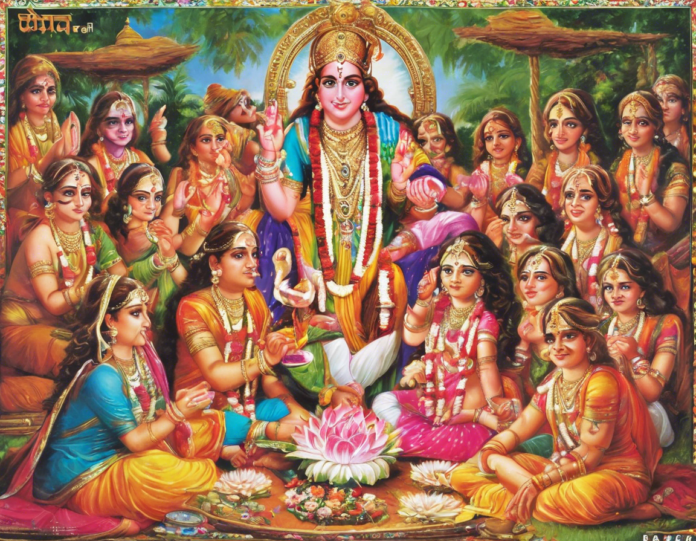Introduction
Pradosh Vrat, also known as Pradosham or Pradosha, is a highly auspicious fasting day observed by devotees of Lord Shiva in Hinduism. It falls on the 13th day of both the waxing (Shukla Paksha) and waning (Krishna Paksha) phases of the moon. The word “Pradosh” refers to the twilight period just before sunset and after sunset, which is believed to be the most opportune time to seek the blessings of Lord Shiva.
The Story Behind Pradosh Vrat
According to Hindu mythology, there is a fascinating story behind the significance of Pradosh Vrat. It is said that during the churning of the cosmic ocean (Samudra Manthan) by the Devas (celestial beings) and Asuras (demons) to obtain the nectar of immortality (amrita), a deadly poison known as Halahala emerged from the ocean. This poison was so potent that it threatened to destroy the entire universe.
In their desperation, the Devas and Asuras turned to Lord Shiva for help. Being the compassionate Lord, Shiva drank the poison to save the universe. However, to prevent the poison from harming him, Lord Shiva’s consort, Goddess Parvati, held his throat, causing the poison to remain stuck there. As a result, Lord Shiva’s throat turned blue, earning him the name Neelakantha (the one with a blue throat).
The day when Lord Shiva consumed the poison and saved the universe is celebrated as Maha Shivaratri. The period just before sunset on this day, when Lord Shiva’s act of consuming the poison took place, is regarded as the most propitious time and is known as Pradosh.
Significance of Observing Pradosh Vrat
Observing Pradosh Vrat is believed to bestow devotees with blessings, forgiveness of sins, prosperity, and liberation from the cycle of birth and death. It is said that those who fast and offer prayers to Lord Shiva during Pradosh Vrat with sincerity and devotion are granted their wishes and protected from evil forces.
Rituals and Customs of Pradosh Vrat
• Fasting: Devotees observing Pradosh Vrat abstain from food and water from sunrise until the Pradosh period in the evening when they break their fast after performing the rituals.
• Puja: In the evening, devotees take a bath, wear clean clothes, and visit a Shiva temple to perform the Pradosh Vrat puja. The puja typically involves offering milk, bael leaves, flowers, fruits, incense, and lamps to Lord Shiva.
• Chanting Mantras: Reciting prayers, Shiva mantras, and the sacred Shiva Chalisa are an integral part of Pradosh Vrat. The chanting of these mantras is believed to please Lord Shiva and invite his blessings.
• Pradosh Katha: The storytelling of the significance of Pradosh Vrat and the legend associated with it is an essential custom during the puja.
• Participating in Pradosh Vrat Katha: Some devotees also choose to attend group recitals of the Pradosh Vrat Katha in temples or religious gatherings.
• Lighting Lamps: Lighting diyas or lamps with ghee or sesame oil is considered auspicious during the evening prayer.
• Offering Prayers: Devotees offer their prayers to Lord Shiva, seeking his grace and blessings for good health, prosperity, and spiritual upliftment.
Benefits of Observing Pradosh Vrat
• Removal of Obstacles: Pradosh Vrat is believed to remove all obstacles and hurdles from the path of devotees.
• Fulfillment of Desires: Worshipping Lord Shiva on Pradosham is said to fulfill the wishes and desires of devotees.
• Protection: Observing Pradosh Vrat is believed to protect individuals from negative energies and evil influences.
• Spiritual Growth: The spiritual practices and penance undertaken during Pradosh Vrat are thought to contribute to the spiritual evolution of individuals.
FAQs (Frequently Asked Questions)
- Can anyone observe Pradosh Vrat?
-
Yes, anyone can observe Pradosh Vrat regardless of age or gender. It is a highly auspicious fast open to all devotees of Lord Shiva.
-
Can Pradosh Vrat be observed at home?
-
Yes, Pradosh Vrat can be observed at home with devotion and sincerity by following the rituals and customs associated with it.
-
Is it necessary to visit a temple to observe Pradosh Vrat?
-
While visiting a temple is ideal for observing Pradosh Vrat, one can also perform the rituals and prayers at home with equal reverence.
-
What should one eat after breaking the fast of Pradosh Vrat?
-
It is recommended to break the fast with simple and sattvic food like fruits, milk, or light vegetarian meals.
-
Can pregnant women observe Pradosh Vrat?
-
Pregnant women are advised to consult their healthcare provider before observing any form of fasting, including Pradosh Vrat.
-
Is it necessary to chant specific mantras during Pradosh Vrat?
-
While chanting specific mantras dedicated to Lord Shiva is beneficial, sincerity and devotion in prayers hold more significance.
-
What is the duration of the Pradosh Vrat fast?
-
The Pradosh Vrat fast begins at sunrise and concludes after the evening puja during the Pradosh period.
-
Are there any specific rules to follow during Pradosh Vrat?
-
Observing cleanliness, maintaining a pure state of mind, and dedicating oneself to Lord Shiva with devotion are essential rules to follow during Pradosh Vrat.
-
Can one observe Pradosh Vrat without fasting?
-
While fasting is recommended during Pradosh Vrat, those unable to fast can still observe the rituals and prayers with devotion.
-
What is the significance of offering bael leaves to Lord Shiva during Pradosh Vrat?
- Bael leaves are considered sacred and dear to Lord Shiva. Offering bael leaves symbolizes purity, devotion, and the removal of sins.
In conclusion, Pradosh Vrat holds immense significance in Hindu mythology and spiritual practices. Observing this fast with faith and devotion is believed to bring blessings, prosperity, and liberation. By understanding the rituals, customs, and benefits associated with Pradosh Vrat, devotees can deepen their connection with Lord Shiva and experience spiritual growth and well-being.

